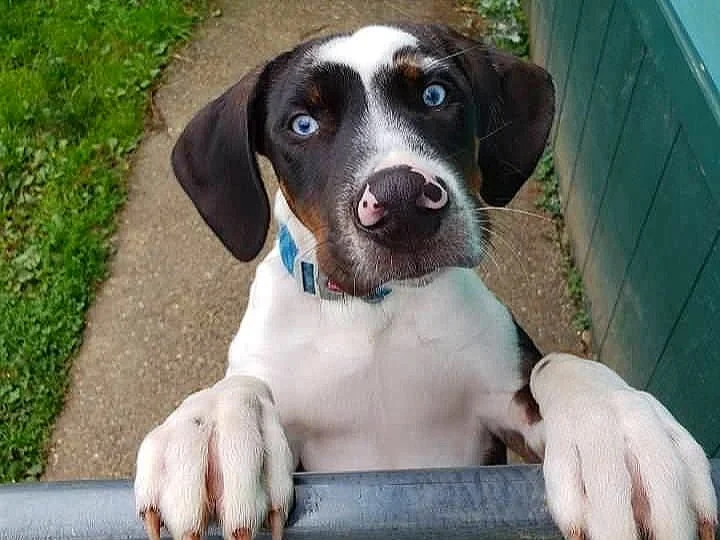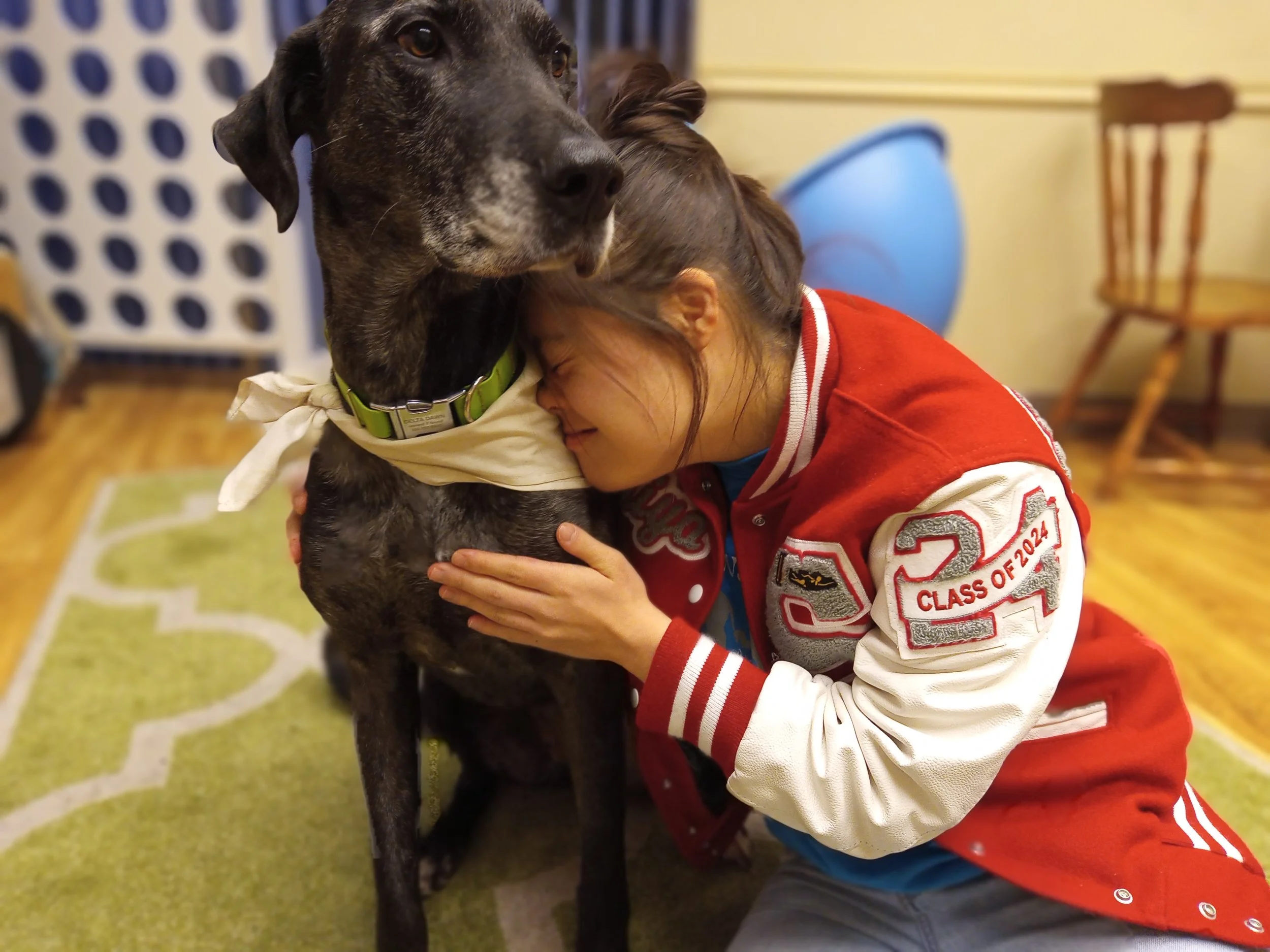
Puppy Wiggles and Children’s Giggles
Articles about animal-assisted speech therapy
Your animal-assisted therapy resources are here!
Your animal-assisted therapy resources are here!
Now there’s two resources to help you start your therapy dog journey today!
Sky’s First Day: A new speech therapy dog learns the ropes of animal-assisted interventions
Though still training for our Canine Good Citizen test, the wonderful families and Arlington Speech & Reading welcomed Sky in for a day to learn the ropes of speech therapy dog.
She has already been a few times before without seeing any kids to adjust to the environment and a couple partial days to meet families as a transition into the expected workload.
Follow along for ideas of how to transition your own therapy dog into your work.
Top 3 Mistakes I Made When Starting Animal-Assisted Interventions with a Speech Therapy Dog
Perhaps there are SLPs out there who always know exactly what to do, always execute their plan perfectly, and have amazing outcomes with every client. I am not one of those professionals. However, I care deeply about my profession and helping the families I serve and I’m (usually) willing to learn from my mistakes. When I decided to start bringing a speech therapy dog to work, I honestly didn’t have a clue what I was doing. I did my best to figure it out as I went with the limited resources I could find at the time. Five years later I have learned so much both about the theory behind animal-assisted interventions and practical daily application in a speech therapy setting. Let me share the 3 biggest things I wished I’d known when I started.
Reading to a Therapy Dog; More Opportunities Than You May Realize
Therapy Dogs and reading, they go together like peanut butter and jelly! But perhaps for more reasons than you realize.
Sure there are popular programs where children take turns reading to a patient dog at school or a library, but did you realize there’s other ways to involve a canine companion to directly target specific literacy skills? Read on to find my three favorite ways to incorporate animal-assisted interventions with my reading clients, plus one I’m excited to try.
No Therapy Dog? No Problem. Animal-Related Engagement in Pediatric Speech and Language Therapy
Have you ever stumbled upon a helpful tool or technique to use with your speech therapy clients but had no idea what it was called? Or been surprised that something you’ve intuitively been doing actually has a name and research behind it? If you’re already using therapy materials with animal characters and themes, then you’ll probably be pleased to know you’re already using Animal-Related Engagement, or ARE.
A Day in the Life of a Speech Therapy Dog: How Delta Spends Her Time at a Pediatric Speech and Language Therapy Clinic
The giggle was infectious. It was such a simple game, sorting items pulled from Ned’s Head into pink and purple piles, but somehow the idea that therapy dog Delta wanted the purple items next to her had tickled Bristol’s funny bone. Working diligently to produce a /k/ at the end of “pink” as Delta patiently rested alongside her, a pile of purple items between her paws, I couldn’t help but marvel at how much value Delta’s simple presence was bringing to this moment, and for this session all she had to do was lie there…
Why Not all Good Dogs Make Good Therapy Dogs
Are you wondering if your furry best friend might be a good addition to your speech therapy sessions? Good speech therapy dogs are rare and I’ve found that certain inherent personality traits have more impact on a dog’s candidacy than any training can make up for. Here’s the journey of Bodhi, Sky, and what I’ve learned in training these two pups for animal-assisted speech therapy.
How Can I Incorporate a Speech Therapy Dog to Better Engage Teens?
I work with a number of teens for animal-assisted speech therapy, some of whom come to me after years of working on residual speech sound errors, lingering expressive language errors, or social communication challenges. Teens are going through a lot and coming to speech therapy is often low on their priority list. Without exception, teens are my favorite age group with which to incorporate my therapy dog to build excitement about therapy, empower a growth mindset, and even for a little self-care after a challenging session.
Am I Ready to Add a Speech Therapy Dog?
When I started providing animal-assisted speech therapy, I was realizing a long-held dream but also starting a new learning journey. Without a lot of resources on the topic that related to our field, I jumped in and figured it out as I went. Now nearly five years later, with a book about speech therapy dogs under my belt, I’m ready to share the lessons I’ve learned with other SLPs who are also considering this challenge. Here are some thoughts for an SLP or related professional to consider about their own skills and resources before adding a therapy dog.
5 Myths about Therapy Dogs: A Guide for Speech-Language Pathologists
If you google “therapy dog”, you’ll find plenty of images of serene-looking Golden Retrievers and Labradors, usually resting quietly alongside a person who is elderly or disabled. Human interest stories aimed at the public often celebrate a therapy dog that is trained to perform lots of tricks to entertain or assist. If your canine partner doesn’t fit this mold, you may think it’s impossible to use him or her in a professional role, but did you know that the core feature of a therapy dog is actually the ability to form a powerful human-animal bond? And that can look many different ways! Let’s explore a few common misconceptions about speech therapy dogs as you decide if animal-assisted speech therapy is right for your practice:
Why Would an SLP Incorporate a Therapy Dog?
Are you wondering if including a therapy dog into your SLP practice could be right for you? Have you dreamed of bringing your beloved pet to work? Do you feel unsure about how to get started in animal assisted interventions? I had all these thoughts myself when I decided to dive into the world of speech therapy dogs in 2019. I’ve learned a lot through trial and error, finding some great resources, and developing a team of both dog experts and master clinicians to help refine my skills. I want to help other SLPs interested in building a skill set around animal assisted therapy and more specifically, partnering with a therapy dog. My dogs Delta Dawn, Johnny Utah, and Bodhi have all challenged and improved me as both a person and a speech therapist. I’d like to share our journey through this blog.












